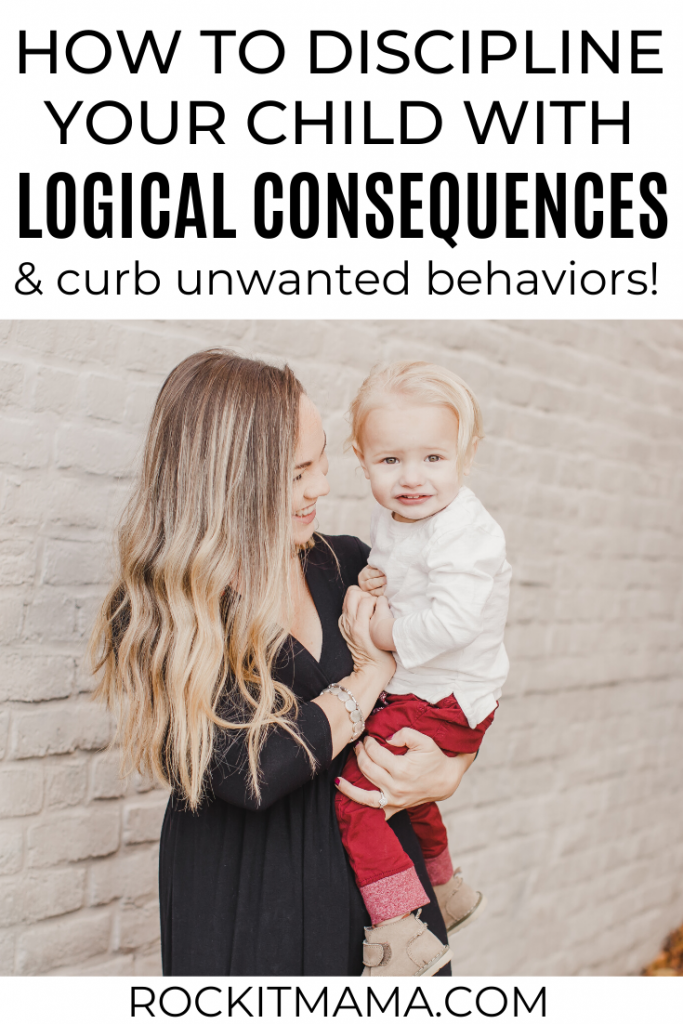With my child’s emotional health at the forefront of my parental priorities, positive parenting solutions have been a saving grace. Positive parenting allows for behavior correction while simultaneously building self-esteem and emotional intelligence. A key strategy of positive parenting is logical consequences.
Logical consequences include a cause and effect relationship. They emphasize poor behavior without disparaging or belittling the child. And get this: they actually work! If you’ve hit a wall with discipline and are finding that punishments just aren’t working, give logical consequences a shot and watch as the relationship (and poor behaviors) improve.

Logical Consequences
First, let’s distinguish the difference between consequences and punishments. Punishments are designed to shame a child into compliance and are unrelated to the bad behavior or damage done. Logical consequences are related to the behavior, and should be reasonable for the offense committed.
The message is clear with logical consequences; the behavior is unwanted, not the child. The behavior is bad, not the child. The behavior needs correction, not the child. The goal of logical consequences is to stop misbehaviors and allow children to make more constructive choices in the future.
When implementing logical consequences consider the 3 Rs.
Reasonable: the consequence should come from sound judgement, and needs to be fair and sensible. Try not to go overboard. A good way to ensure that a consequence is coming from a good place, is to step back from anger. Implement the reasonable consequence once the situation has deescalated.
Respectful: the consequence needs to be free from shame or disparagement, and should not be intended to manipulate or coerce. Logical consequences should provide an opportunity for a child to grow and learn from their mistake without stifling emotional development.
Relatable: the consequence should have a definitive correlation to the behavior itself. The child needs to be able to connect the bad behavior to its consequence, in order to understand the wrongdoing.
Examples of Logical Consequences:
- If a child doesn’t brush his teeth, he isn’t allowed dessert.
- If a child throws a toy at someone, the toy is taken away.
- If a child receives a poor grade, they must spend extra time after school studying.
- If a child is mean to little brother at bath time, they are no longer allowed to bathe together.
For instance, in a fit of frustration, my son threw a straw from his capri sun at me. The logical consequence to that action, is no capri suns for lunch the next day. Reasonable, respectful and relatable. Those are the key elements of a logical consequence.
Another component to logical consequences is setting expectations and following through. Be sure that the child knows what the standards are for good behavior, and call out when they exceed those limits. And remember, a logical consequence that is simply a “threat” with no follow up will be ineffective. Consistency and execution are crucial to implementing logical consequences that work.
Restorative Practices
Subsequent to logical consequence are restorative practices. If a bad behavior causes damage or harm, a good way to teach and rectify, is to use restorative practices. A key element of restorative practices or justice is empathy. When a child is obligated to remedy a wrong-doing, they begin to understand the extent of the damage caused by their poor choice and the effort it takes to fix it.
Examples of Restorative Practices:
- If a child colors on the walls, she cleans the wall.
- If a child knocks down another’s tower, she rebuilds it for them.
- If a child dumps their milk out, they clean up the mess.
- If a child throws trash on the floor, they come back to take it to the proper receptacle.
It makes perfect sense, right? You break it, you fix it. You dump it, you clean it.
With restorative practices, the offender is responsible for making things right, which builds the kind of character we want to see in our children. In addition, restorative practices can develop personal responsibility and accountability. Two important things that imposing punishment alone, will not accomplish.
Natural Consequences
As the old saying goes, “If you don’t listen, you feel.”
What we “feel” is the natural consequence of not making a good decision.
Similar to logical consequences yet slightly different, natural consequences happen as the result of an action, but aren’t implemented or enforced by a caregiver.
Examples of Natural Consequences:
- Not wearing a coat and feeling cold.
- Leaving toys outside and finding them ruined by the rain.
- Forgetting homework at home and not receiving credit for it.
As parents, we often feel the urge to remove obstacles our children face in order to spare them discomfort. The reality is, it can be beneficial to let kids experience things firsthand in order for it to have a lasting impact. If a child has their stuffed animal ruined or stolen after leaving it outside, the pain or discomfort they feel will propel them to consider a behavior change, such as leaving stuffed animals inside next time.
Natural consequences can be hard to allow without parental interference. However, allowing a consequence to happen naturally can build resiliency and encourage healthy decision making skills.
A few key components to natural consequences:
There are definitely situations where allowing a natural consequence would not be appropriate. When a child’s safety or overall well-being is in jeopardy, another form of discipline should be implemented. For example, a child playing in the road or refusing to brush their teeth. The danger of playing in the street and the health implications of not brushing teeth override the learning experience of a natural consequence. The child should also be old enough to comprehend the reason for the consequence.
Additionally, a parent should not participate in “I told you so” shaming of a child after experiencing a natural consequence. Always approach a child with empathy and validate their feelings to promote emotional health. Respect works both ways! The goal is not to shame a child into making better choices, but to provide them the opportunity to do so.
We hope these strategies work for you and improve the relationship you have with your child! For more positive parenting advice, check out our Positive Language Alternatives to Tame a Child’s Tantrum.
More guidelines for positive parenting here.









